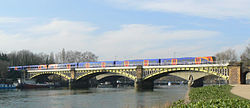
Back Richmond Railway Bridge Czech Richmond Railway Bridge German Σιδηροδρομική γέφυρα του Ρίτσμοντ (Λονδίνο) Greek Puente ferroviario de Richmond Spanish Richmond Railway Bridge Italian Richmond Railway Bridge Slovak
Richmond Railway Bridge | |
|---|---|
 Richmond Railway Bridge looking downstream | |
| Coordinates | 51°27′36″N 0°18′49″W / 51.46°N 0.3136°W |
| Carries | National Rail services operated by South Western Railway |
| Crosses | River Thames |
| Locale | Richmond |
| Other name(s) | Richmond Windsor and Staines Railway Bridge[1] |
| Maintained by | Network Rail |
| Heritage status | Grade II listed structure[1] |
| Characteristics | |
| Design | Truss arch bridge |
| Material | Steel |
| Total length | 91.5 metres[1] |
| No. of spans | 3 |
| History | |
| Designer | Joseph Locke (1848); J W Jacomb-Hood (1908) |
| Opened | 1848; rebuilt 1908[1] |
| Statistics | |
Listed Building – Grade II | |
| Official name | Richmond Railway Bridge and Approach Viaduct |
| Designated | 26 November 2008 |
| Reference no. | 1393016 |
| Location | |
 | |
Richmond Railway Bridge in Richmond, south-west London, crosses the River Thames immediately upstream of Twickenham Bridge. It carries National Rail services operated by South Western Railway (SWR) on the Waterloo to Reading Line, and lies between Richmond and St. Margarets stations. The bridge was amongst the first railway crossings of the Thames.[1]
The first Richmond Railway Bridge was built by the contractor Thomas Brassey and designed by the civil engineers Joseph Locke and J. E. Errington on behalf of the London and South Western Railway (L&SWR). Opened during 1848, it was originally known as the Richmond Windsor and Staines Railway Bridge.[1] Due to concerns over the bridge's use of cast iron in its construction, it was rebuilt during the 1900s, the principal change being the substitution of iron elements for steel counterparts. This second bridge, which heavily reused elements of the original, was designed by the L&SWR's then-chief engineer, J. W. Jacomb-Hood, and constructed by the Horseley Bridge Company between 1906 and 1908.
The second bridge is visually similar to the earlier structure, retaining much of its aesthetics and original features despite subsequent refurbishment and maintenance programmes, including the replacement of its decking and girders during the 1980s. Since 2008, both the bridge itself and its brick approach viaduct have been Grade II listed structures, protecting them from unsympathetic alterations.
© MMXXIII Rich X Search. We shall prevail. All rights reserved. Rich X Search